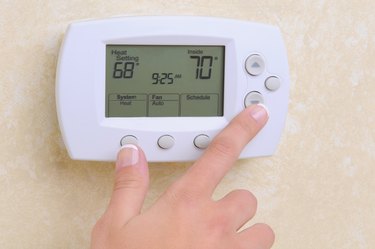
You rely on your heating and cooling system to keep you comfortable year-round, and a big part of the HVAC system is the thermostat. Without it, your furnace and air conditioner don't know when to turn on or off. It's relatively easy to troubleshoot a thermostat when it stops working correctly, whether it won't turn on at all or seems to be running the HVAC system incorrectly.
Check the Settings
Video of the Day
Don't overlook the simplest solution if your HVAC system seems like it's not working properly. The settings on your thermostat can get changed by other family members or changed accidentally if the thermostat gets bumped when people walk by. Verify that the thermostat is turned to "heat" or "cool" depending on what you want to run. If the fan is running constantly, make sure it's on the "auto" setting instead of "on," which causes it to run nonstop.
Video of the Day
Check the temperature setting on the thermostat. If you're running the air and the thermostat is set higher than the current temperature, it won't run until the house warms up to that temperature. In cold weather, your furnace won't run until the house cools down to the temperature setting you choose. Try adjusting the temperature setting higher or lower to see if the HVAC system starts running.
Change the Batteries
Many modern thermostats, including programmable thermostats, have batteries that occasionally need to be replaced. If your thermostat isn't working correctly, look for a low battery indicator on the unit. Sometimes, the screen of the thermostat goes blank when it needs fresh batteries. Try installing new batteries if your thermostat uses them to see if that corrects the issue.
If the batteries are fine, check the power at the breaker box. Check for a tripped breaker and turn it back to the "on" position if necessary. Check the furnace switch, which looks like a light switch that's usually mounted on the furnace or nearby on the wall. It needs to be switched to the "on" position for the system to run.
Inspect the Wiring
Before you go anywhere near the thermostat wiring, shut off the circuit breaker that powers it to prevent shocks. Pull the cover off the thermostat to reveal the inner workings and check the thermostat wire connections. Look carefully at each wire to ensure it's secure and not corroded. Screws often hold the wires in place. If there's an issue, you can use a screwdriver to remove the wires so you can cut them, strip the sheathing, and reattach them to the screws to get a secure, uninterrupted connection.
Clean the Thermostat
Sometimes a thorough thermostat cleaning is all it needs to run smoothly. Mechanical-style thermostats have various sensors, contact points, levers, and other parts inside that need to be cleaned carefully. Use a small, soft paintbrush or cotton swabs to clean them gently, being careful not to bend any parts. A can of compressed air can also clean out the dust, pet hair, and other debris that can affect the thermostat.
Consider the Location
A bad location for your thermostat can interfere with how it functions. The best spot is on an internal wall in a central location away from direct sunlight and drafts. Those exterior forces can affect the accuracy of the thermostat and cause your HVAC system to run incorrectly. If it's near a space heater or another item that generates heat, the thermostat could experience inaccurate readings. Consider having an HVAC pro relocate the thermostat if it's in a bad location.